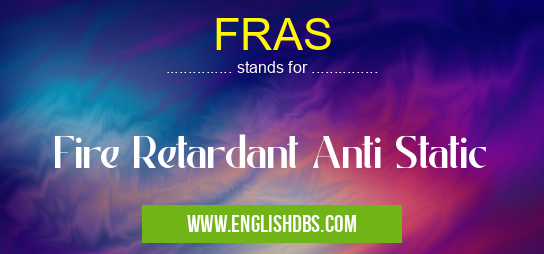What does FRAS mean in CONSTRUCTION
The acronym FRAS stands for Fire Retardant Anti Static. This designation is commonly used to describe fabrics and other products that have been treated to resist fire, flames, and static electricity. Fire retardant materials are often found in industries such as industrial manufacturing, the military, and the medical field. The combination of fire retardants and anti-static properties makes FRAS a valuable asset in many areas due to its ability to provide safety and protection from dangerous conditions.

FRAS meaning in Construction in Miscellaneous
FRAS mostly used in an acronym Construction in Category Miscellaneous that means Fire Retardant Anti Static
Shorthand: FRAS,
Full Form: Fire Retardant Anti Static
For more information of "Fire Retardant Anti Static", see the section below.
Uses of FRAS
FRAS fabrics are used for a variety of purposes in industries such as industrial manufacturing, medicine, auto racing, aviation, mining, electrical engineering, and firefighting. They are especially useful in hazardous areas due to their ability to resist sparks from welding machines or grinders as well as flames caused by explosions or combustibles. Additionally, they offer protection against electric shocks from faulty wiring or equipment that may overheat. FRAS fabrics are also favored in high-risks work environments where workers may come into contact with flammable liquids like petroleum or combustible dust particles like those found in flour mills or woodworking shops.
Advantages of Using FRAS Fabrics
The primary advantage of using FRAS fabrics is added safety for workers who may be exposed to potential dangers such as fires or electrocutions while on the job. Additionally, certain types of fire retardants can help protect against corrosion caused by chemicals like cleaning agents or fertilizers, reducing maintenance costs associated with replacing worn out protective gear more frequently than otherwise necessary. Lastly, the anti-static properties help reduce costly downtime caused by static charge accumulation from workers’ clothing interfering with sensitive electronic equipment.
Essential Questions and Answers on Fire Retardant Anti Static in "MISCELLANEOUS»CONSTRUCTION"
What is FRAS?
FRAS stands for Fire Retardant Anti Static, which refers to fire retardant materials that are also designed to be static dissipative.
What are the benefits of FRAS?
FRAS provides additional safety and performance benefits such as improved fire resistance, enhanced product durability, better shock absorption, and improved electrical conductivity.
How is FRAS used?
FRAS is often used in a variety of industries including automotive, aerospace, military and medical applications. It can also be used for furniture and flooring in commercial buildings.
What types of fabrics are treated with FRAS?
Fabrics such as polyester, cotton blends and wool are typically treated with FRAS coatings in order to provide the fire resistant qualities.
Is there a difference between Fire Retardant Fabric (FRF) and FRAS fabric?
Yes, there is a difference between Fire Retardant Fabric (FRF) and FRAS fabric. The primary difference lies in the fact that while both fabrics will resist burning or melting when exposed to high heat sources like open flames, a material treated with Fire Retardant Fabric (FRF) will only resist burning or melting momentarily while an item treated with FRAS fabric will continue to resist burning or melting for much longer periods of time due to its anti-static properties.
What kinds of tests are required before an item can be approved for use with FRAS?
A series of flame tests must be conducted in addition to other tests including flammability testing using an ignition source test method related to the intended use environment; impact/abuse testing; corrosion testing; and accelerated aging testing. Additionally, items must pass testing specific to the material type such as UV exposure time/intensity if coated films are present; humidity levels if applicable; ozone levels if applicable; temperature cyclic or shock freeze/thaw if applicable.
What industries most commonly use FRAS materials?
Common industries that utilize fire-retardant and anti-static properties of these materials include aerospace, automotive manufacturing, medical equipment design, furniture production and military applications.
Final Words:
In conclusion, FRAS provides a great benefit by combining two important pieces of safety technology—fire retardants and anti-static treatments—into one beneficial fabric that can provide extra protection against fire hazards as well as electrostatic discharges (ESDs). It is highly recommended for use in industries where workers come into contact with flammable liquids and combustible dusts as well as where electric shocks could cause injury or damage electronics systems if left unprotected.
